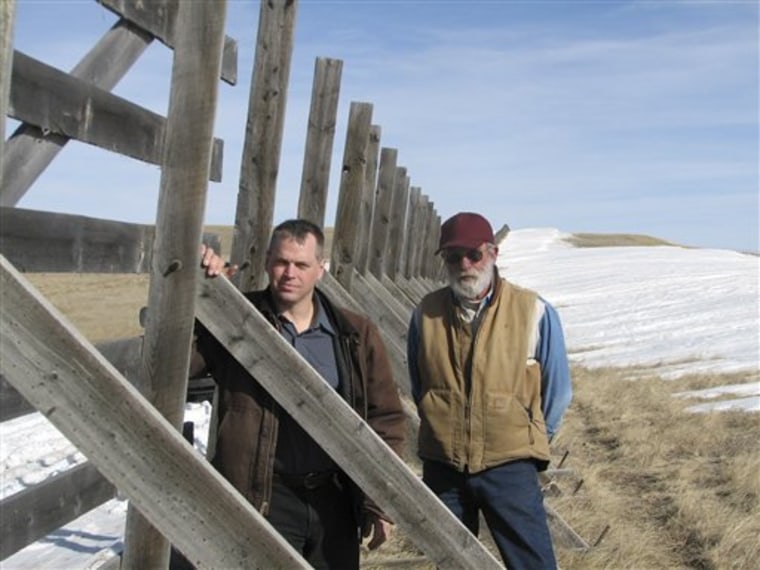They're a fixture along Wyoming's wintry, wind-blown roadways — fences that have spent up to 50 years blocking blowing snow and keeping roadways clear of drifts in the winter.
Now snow fences are finding a second life as green building material for homes and businesses worldwide, a Wyoming twist on a trend that's sent carpenters scavenging in old barns and abandoned buildings in search of boards with a distinctively weathered look.
Centennial Woods Inc., which is based near Laramie, reclaims the rustic, weather-worn snow fences and sells the wood to builders who want recycled products as their industry moves toward environmentally friendly construction practices.
"People are just looking for a good, true, solid wood product that they can use without guilt," said John Pope, Centennial Woods Inc. president and chief executive.
Centennial Woods points out that its product saves trees that otherwise would be chopped down to make construction lumber, and it doesn't take as much energy as new lumber to turn into useful material. Builders use the reclaimed lumber for flooring, siding, paneling, wainscoting and other materials.
"What we really did is we recognized by building a national and international market for the wood, by highlighting its green aspects and its beauty, that we could grow this into a substantial business," Pope said during a recent drive near Cheyenne, where stretches of snow fence undulate with the hilly terrain.
Builders and architects find the wood appealing because of, not despite, its rough appearance and existence. Most of the wood reclaimed by Centennial Woods has not been painted or treated with waterproofing chemicals. Any natural moisture in the wood has been dried out by years of exposure to the wind and sun.
"It takes on a look all of its own that you can't create," said Margie Hamrick, a builder and developer in Vail, Colo., who uses green materials in her projects. "And what I like about it, is not only the rustic look and feel of the material, but I like the idea of not cutting down a tree to build a house."
Kermit Baker, an economist with the Washington, D.C.-based American Institute of Architects, said surveys by his organization indicate growing use of recycled materials in building projects around the nation.
"It certainly is on an upward trajectory in terms of popularity," Baker said.
Pope has seized on the trend to grow the business. When Centennial Woods first opened in 1999, it focused on supplying wood to clients building rustic buildings, such as ski resorts in the Rocky Mountains and outdoor retail stores like Bass Pro Shops.
But the advent of the green building market has resulted in new clients and new products.
"Now we also sell wood to places like Kansas City, Dallas, Boston, Manhattan, Los Angeles, Portland," Pope said. "Those customers aren't looking for rustic. They're looking for responsible, reclaimed building materials that look good, that are available in enough quantity that they know they can complete their projects, that are high quality."
The snow fence wood costs about the same as cedar if you factor in any weatherproofing treatment needed for the cedar, he said.
Pope declined to release the companies' specific sales figures, but said the business has gone from reclaiming four to six miles of snow fence per year when it first started in 1999 to 20 to 25 miles now. The company employs 25 to 30 workers during its peak times in the summer, up from one full-time employee in 2000.
"Five years ago, we probably could have credibly sold wood into maybe 10 or 15 markets in the United States," Pope said. "Right now it's probably more like 400 or 500. And the difference is green building."
Since 1999, Centennial Woods has reclaimed more than 5 million feet of snow fence for other uses, which Pope estimates saved about 9,000 metric tons of carbon dioxide from entering the atmosphere. With demand for the company's wood increasing, Centennial Woods expects to save an additional 2,000 metric tons of CO2 this year alone, said Pope, who has a doctorate in physical chemistry.
There's plenty of the snow fence wood in Wyoming, where the Wyoming Department of Transportation has erected about 200 miles of snow fence — from 8 to 14 feet tall — over the years. That's more than any other state, said Ken Shutlz, state maintenance engineer with the transportation department.
Centennial Woods has a state contract to reclaim any of the fence that needs to be replaced. In the past, most of the wood was either burned or discarded in landfills.
Hamrick recently built a "green certified" 10,000-square-foot, six bedroom home in the Vail area. Centennial Wood was used to make bunk beds in one bedroom, and Hamrick plans to use the wood more extensively in her next home project.
"People go in and they see it and they go 'Oh, it's so beautiful,' and then you start telling them about the story and all of a sudden the room takes on just a whole 'nother realm," she said. "It's almost like being in a museum or something. It's like 'Oh, the snow fence room, the Wyoming snow fence room.'"
